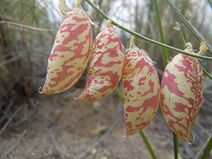Astragalus ceramicus var. filifolius
| Astragalus ceramicus var. filifolius | |
 | |
| Light: | |
| Moisture: | |
| Soil pH: | 5.6-8.4 |
| Height: | 1' |
| Native to: | |
| Nitrogen Fixer | |
| Edible Rating: | |
| Tea: | Yes |
Astragalus ceramicus var. filifolius (common name: painted milkvetch) also known as Astragalus pictus-filifolius
Propagation: Seed - best sown as soon as it is ripe in a cold frame[1]. A period of cold stratification may help stored seed to germinate[1]. Stored seed, and perhaps also fresh seed, should be pre-soaked for 24 hours in hot water before sowing - but make sure that you do not cook the seed[2][1]. Any seed that does not swell should be carefully pricked with a needle, taking care not to damage the embryo, and re-soaked for a further 24 hours[2][1]. Germination can be slow and erratic but is usually within 4 - 9 weeks or more at 13°c if the seed is treated or sown fresh[2]. As soon as it is large enough to handle, prick the seedlings out into individual pots and grow them on in the greenhouse for their first winter, planting them out into their permanent positions in late spring or early summer, after the last expected frosts.
Cultivation: We have very little information on this species and do not know if it will be hardy in Britain, though judging by its native range it should succeed outdoors in many parts of this country. The following notes are based on the general needs of the genus.
Requires a dry well-drained soil in a sunny position[3].
Plants are intolerant of root disturbance and are best planted in their final positions whilst still small[1].
This species has a symbiotic relationship with certain soil bacteria, these bacteria form nodules on the roots and fix atmospheric nitrogen. Some of this nitrogen is utilized by the growing plant but some can also be used by other plants growing nearby[1]. Many members of this genus can be difficult to grow, this may be due partly to a lack of their specific bacterial associations in the soil[1].
Range: Western N. America - C. Idaho and E. Montana, Dakota and Nebraska.
Habitat: Sand dunes and prairies[4].
Edibility: Root - raw[5][6][7][8]. Sweet[9]. In America it is dug up after rain and eaten as sweets[10][11][9][12].
Pollinators: Bees, lepidoptera
Soil: Can grow in light and medium soils.
Drainage: Prefers well drained soil.
Flower Type: Hermaphrodite
Known Hazards: Many members of this genus contain toxic glycosides[13]. All species with edible seedpods can be distinguished by their fleshy round or oval seedpod that looks somewhat like a greengage[14]. A number of species can also accumulate toxic levels of selenium
Also Known As: A. ceramicus.
Links
References
- ↑ 1.0 1.1 1.2 1.3 1.4 1.5 1.6 Huxley, Anthony. The New Royal Horticultural Society Dictionary of Gardening. MacMillan Press, 1992.
- ↑ 2.0 2.1 2.2 Rice, Graham. Growing from Seed Volume 2. Thompson and Morgan, 1988.
- ↑ Chittendon, Fred. RHS Dictionary of Plants. Oxford University Press, 1951.
- ↑ Hitchcock, Leo. Vascular Plants of the Pacific Northwest. University of Washington Press, 1955.
- ↑ Uphof, Johannes. Dictionary of Economic Plants. Weinheim, 1959.
- ↑ Usher, George. A Dictionary of Plants Used by Man. Constable, 1974.
- ↑ Tanaka, Tyōzaburō. Tanaka's Cyclopaedia of Edible Plants of the World. Keigaku Publishing, 1976.
- ↑ Kunkel, Günther. Plants for Human Consumption. Koeltz Scientific Books, 1984.
- ↑ 9.0 9.1 Whiting, Alfred. Ethnobotany of the Hopi. North Arizona Society of Science and Art, 1939.
- ↑ Yanovsky, Elias. Food Plants of the North American Indians Publication 237. US Department of Agriculture.
- ↑ Weiner, Michael. Earth Medicine, Earth Food. Ballantine Books, 1980.
- ↑ Moerman, Daniel. Native American Ethnobotany. Timber Press, 1998.
- ↑ Frohne, Dietrich and Hans Pfänder. J. A Colour Atlas of Poisonous Plants. Timber Press, 1984.
- ↑ Harrington, Harold. Edible Native Plants of the Rocky Mountains. University of New Mexico Press, 1967.